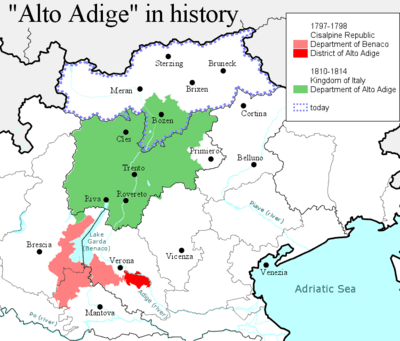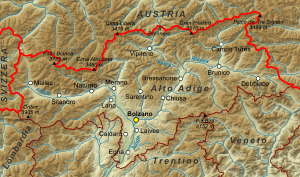Alto Adige facts for kids
Alto Adige is the Italian name for a special area in northern Italy. It's located near the Alps, which are tall mountains. The name comes from the Adige River, which is the second longest river in northern Italy. "Alto" means "upper" in Italian. So, "Alto Adige" means "Upper Adige," because the upper part of the river flows through this area.
The name was first used by the French during the time of Napoleon. They wanted to show that this Italian-speaking area was different from the Austrian region called Tyrol, which is just to the north.
Contents
History of the Name
The name "Alto Adige" was created in the late 1700s. This happened when Napoleon took control of northern Italy near the Alps.
Today, in Italy, the full official name is "Provincia autonoma di Bolzano - Alto Adige." But most people just call it Alto Adige. This name became official in Italy after World War I because of a scholar named Ettore Tolomei.
Napoleon's government created a special area called the "Department of Alto Adige." This was part of his "Kingdom of Italy" in 1810. It was named after the Adige River, which starts in this province.
Today, Alto Adige is the Italian name for the part of Tyrol that is south of the Brenner Pass. It forms a region with Trentino. This region is called Trentino-Alto Adige/Südtirol. The official capital is Trento, but Bolzano also acts as a capital.
After World War II, most people in Alto Adige spoke German. About 65% spoke German, 30% spoke Italian, and 5% spoke a Latin language. By 2011, the numbers changed a bit. About 63% spoke German, 23% spoke Italian, and 4% spoke the Latin language. The other 10% were people who moved there from outside Italy.
Napoleon's Influence and Later Changes
When the French controlled the region, they officially called it Haut Adige. This was to make sure people didn't connect it to the old "County of Tyrol" of Austria.
Napoleon first created the District of Alto Adige. It was part of the "Dipartamento del Benaco" in his Cisalpine Republic. This area was near Verona. But this "Benaco" department was soon removed in 1798.
A few years later, Napoleon created a new "Department Alto Adige" further north. This department was part of the Kingdom of Italy from 1810 to 1814.
This new "Department of Alto Adige" was formed when the Austrian Tyrol was divided. Part of it went to French Bavaria, and part went to the Kingdom of Italy. It included the southern part of German-speaking Tyrol, with the city of Bolzano and its surrounding areas. It also included Trentino.
The borders were decided by Austrian and German officials. They said that a territory would belong to the Kingdom of Italy if Italians lived there. They used the idea: "belonging to the Kingdom of Italy because inhabited by Italians" (da appartenersi al Regno d'Italia perché paese italiano).
This shows that Bolzano was mostly an Italian town during Napoleon's time. But in the next century, it became more German-speaking. By 1911, almost 91% of Bolzano's population spoke German.
Between the Renaissance and the 1800s, the whole area changed a lot. It was originally settled by Latin-speaking people from the Roman Empire. But over time, many German-speaking people moved in. Before Napoleon, only the Dolomite area in the western part of Bolzano province still spoke a Latin language. This was especially true in the Val Venosta near Merano.
Austria controlled the territory, calling it South Tyrol, until 1918. During this time, Austria tried to make the area more German. After World War I, Alto Adige was given to the Kingdom of Italy. This happened even though most of its people spoke German. This decision was made by the Treaty of Saint-Germain.
Italian groups, called "irredentists," wanted Alto Adige to be part of Italy. They believed it was geographically part of Italy. They also said that the area was originally mostly "Ladin language" speaking until the 1300s.
Later, the Italian government encouraged factories to be built in the province. This was to attract Italian workers to move there. Because of this "Italianisation," today about 135,000 people speak Italian as their first language. This is almost one-third of the total population.
Related pages
Images for kids
-
A map from 1874 showing South Tirol with approximately the borders of today's South and East Tyrol
See also
 In Spanish: Provincia autónoma de Bolzano para niños
In Spanish: Provincia autónoma de Bolzano para niños






















